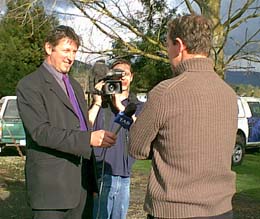Mobile Interviewing Techniques
Shoulder-Mounted Camera

Shooting "off the shoulder" is an easy and flexible method for recording interviews. Typically this will involve one camera, although other cameras can be added easily enough.
This is the most common technique for field shoots in which speed and efficiency are important. A minimum of equipment is required and the production team can move around quickly and easily.
It is also a useful method if the surroundings are likely to be included in the interview. Because the camera operator is so mobile, (s)he can move around and show objects and scenery as they are talked about.
The standard technique is pictured here, with the camera situated just to the side of the interviewer. This gives a nice front-on shot of the guest. The interviewer and camera should be close together so the guest is facing just slightly off-camera.
Off-the-shoulder interviews tend to have quite a different feel to tripod/pedestal interviews. They are less formal, less restricted, and involve more movement. Because the participants are usually standing or moving around, the impression is given of being "up and about" rather than sitting sedately in a studio setting. Indeed, off-the-shoulder cameras are sometimes used in studio settings to achieve this effect.
The amount of movement involved depends on the production requirements. News stories tend to be quite static, concentrating on what the guest has to say and minimising distractions. Programmes which are more entertainment-focused may include a lot more variety, with the camera operator moving around and showing different angles of the guest, presenter and surroundings.
Tripod-Mounted Camera

You can use a tripod in much the same way as above.
Advantages:
- Nice steady shots - important if the interview will be edited alongside other tripod-mounted shots.
- Reduced fatigue for the camera operator, which will make a big difference if the interview is going to be long or if you'll be shooting lots of them. Off-the-shoulder shots can become wobbly as the operator begins to tire.
Disadvantages:
- You are much more restricted in terms of movement and framing.
- You have another piece of equipment to carry around (and good tripods are heavy).
Walking and Talking

A nice effect is the walking IV in which the interviewer and guest stroll side-by-side toward the camera. The camera operator walks backwards maintaining a constant distance. Obviously this must be well planned. The camera operator should have someone to act as a guide — the usual routine is for the guide to place their hand in the middle of the operator's back and walk with them.
In the example pictured here, the sound operator is doubling as the guide (he needs to keep turning his head backwards and forwards to do both jobs).
Field Kit Checklist
- Camera, tripod and plenty of tapes
- Batteries/power + multiboxes and extension leads
- Microphones
- Audio mixer, headset and leads
- Lights, stands and gels
- Video Monitor
- White balance cards
- Shot-log sheets, pen, etc.
Next Page: Remote IVs